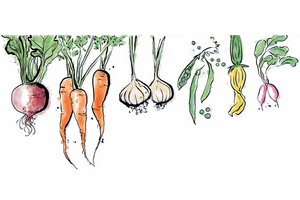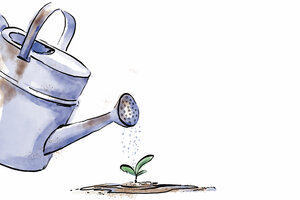Joy in the garden: Books to inspire beauty and self-reliance

Karen Norris/Staff
More people are discovering the joys of growing things in small and large ways – from pots on the windowsill to overturning a section of lawn to make room for native plants and pollinators. Easing the boundaries between indoors and outdoors by tending to plants was one of the first hobbies people cultivated over long months at home during the pandemic. If, after a couple of successful seasons, you are ready to up your game, here is a selection of new titles to inspire, encourage, and even entertain as you get ready to dig in the dirt and watch your garden grow.
Small spaces are no problem
Being a successful gardener doesn’t require a large, sunny backyard, as apartment dweller Amy Pennington proves in Tiny Space Gardening: Growing Vegetables, Fruits, and Herbs in Small Outdoor Spaces. Pennington, who gardens with pots in a 75-square-foot space in Seattle, urges urbanites to foster an intimate connection to growing things: “To be a successful container gardener, you need to think like a plant,” she writes.
For starters, think about nourishing their roots, and choose containers accordingly. Porous clay pots have a lovely rustic look, but plastic pots are lighter to move around and hold moisture longer. Or use a bag of potting soil as your “container.” Since you are a tiny space gardener, your gardening tools can be diminutive, too, such as forks (instead of rakes), spoons (instead of trowels), and measuring cups (instead of shovels) to mix and move soil.
Why We Wrote This
Watching a seedling break through the soil, or harvesting our own produce, can bring joy and pride. Gardening, in whatever space we have, nurtures our families and ourselves.
Pennington is an advocate for using your space for “experiments and experience,” and encourages growers to pick their battles: If you can’t get fussy tomatoes to grow, check out the heirloom offerings at the farmers market. Lettuces, herbs, and edible flowers bring quick and easy rewards. Pennington also includes a few recipes and windowsill projects, such as a microgreens garden.
Back to the land
If you have ever fantasized about trading in city life for foraging for your own food, Tamar Haspel, who writes a food-policy column for The Washington Post, has done it for you in her hilarious memoir To Boldly Grow: Finding Joy, Adventure, and Dinner in Your Own Backyard.
Haspel and her husband, Kevin, pulled up their New York City roots during the financial crisis of 2008 and bought a “very shack-like” house on Cape Cod in Massachusetts. The memoir centers on Haspel’s challenge to expand their urban rooftop gardening skills: eating at least one thing every day for a year that they obtain first hand. In other words, food they either grew, fished, hunted, or gathered.
This launches an odyssey of figuring out what exactly will grow in their sandy-soiled backyard (shiitake mushrooms) and expands to digging up oysters, drilling holes in the ice to fish, corralling flying turkeys, evaporating sea salt into a gourmet delicacy, and eventually “harvesting” deer from a friend’s overpopulated land, among other adventures.
Haspel, who writes the award-winning “Unearthed” column, turns her skills as a science journalist toward solving the perplexing problems that come with living off the land and enticing readers with its many rewards.
A guide to every stage
Ready to roll up your sleeves and start a garden of your own? Gardening for Everyone: Growing Vegetables, Herbs, and More at Home by Julia Watkins is a great beginner’s resource.
Designed as a guide for each stage of the growing season, this book offers plenty of tips and DIY projects from analyzing the amount of sun your plot of land or patio receives to establishing the best growing method for you – raised beds or small containers. There are tips for understanding and testing your soil, and improving it by making compost.
This book grows with you, too. Each year of gardening brings new expertise and opportunities to expand the functionality of your garden, whether it is using native plants to support local pollinators and birds or raising your own vegetables and flowers from seeds.
A chapter titled “Playing” reminds readers there is fun to be had digging in the dirt at any age, and includes projects such as making steppingstones, a gourd birdhouse, and edible flower lollipops, along with a few recipes. Beautiful photographs throughout offer places to rest amid all the good information and instruction, and wide margins invite you to make notes about your own garden.
Keep ’em coming
If you are an experienced gardener but are wanting to step it up a level, Plant Grow Harvest Repeat: Grow a Bounty of Vegetables, Fruits, and Flowers by Mastering the Art of Succession Planting by Meg McAndrews Cowden will help you create a garden with constant blooms that delight and produce that nourishes. The author took her backyard hobby into a full-time job and did it all in the short growing season of Minnesota.
Consider this book a useful guide for the thinking gardener who prefers organic practices. Succession gardening, where one growing cycle yields to the next, promises maximum output for your garden while utilizing space to its fullest. Beginning with fast-growing radishes and cool weather greens, Cowden instructs gardeners with charts and graphs through the crowded mid-season, finishing with beans and sweet corn in August and the return of late harvest greens.
If that doesn’t keep you busy enough, succession planting for perennial and annual flowers ensures pops of color and regular food for pollinators. Cowden explains the art of interplanting by effectively balancing plants as they compete for light, water, and nutrients, and lists some of her favorite flower and vegetable combinations.
Works of floral art
Gardening is hard work and if you’d rather just enjoy the beauty of cut flowers without getting grass stains on your knees The Flower Hunter: Seasonal Flowers Inspired by Nature and Gathered From the Garden by Lucy Hunter is a book charming enough to leave out on your coffee table or offer as a gift.
Hunter, who had a fine-arts background before she shifted to landscape design, lives in North Wales. She conducts global workshops on floral design and has a robust following on Instagram. Her romantic, shabby-chic still lifes – carefully crafted with old treasures and cascades of wildly twisting flowers – offer a kind of escapism if you take some time to pore over her photos and linger over the accompanying essays. Hunter is an artist and she invites readers to “create work that makes you happy.”
This book doesn’t offer too much in the way of practical instruction, aside from a few pages here and there about the best vessels and structure for centerpieces and so forth, but it does encourage readers to really see the beauty in the garden as it changes from season to season.

